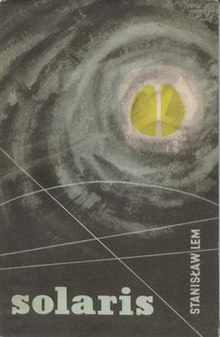A visionary work of first-contact science fiction by the Kafka prize winner, Polish writer Stanislaw Lem saw the light of the day in 1961. It was non-other than ‘Solaris’, which has later been adapted for or inspired popular music, theatre, operas, ballet, video games, and movies by Andrei Tarkovsky and Steven Soderbergh in 1972, and 2002 respectively. The first direct English translation of this literary work penned by Bill Johnston has been published in 2011. Further, it has been translated into over 40 different languages and sold several million copies constantly rediscovering new generations of bibliophiles.
Although Solaris is a classical sci-fi, it stands among others blurring the line between reality and hallucination. Lem sheds light on humankind’s dream of making contact with extraterrestrials while drawing attention to anthropocentrism, and the inability of humans in acknowledging consciousness cleverly. This bestseller of the 60s is indeed a ‘juicy prey for critics’ as Lem has noted in an interview cause ‘Solaris’ is a lot more than the futile space exploration it demonstrates.

Solaris, The Liquid Monster
Similar to many space-themed sci-fi, this story also revolves around extraterrestrial life. Nevertheless, Solaris is not a typical humanoid alien who possesses some unusual appendages. It is a planet! A planet that is orbiting around two suns named red and blue, and is almost completely covered with an intriguing alien ocean. It is strangely intelligent, and no mind can escape its inspection. The more one tries to study Solaris, the more it will study that soul making them confront their innermost secret guilts. Its mode of communication and the parameters of cognizance are completely off the human scale of understanding. Lem brings forward various complex theories of Solaris studies time by time in the form of Kelvin’s thoughts and books on the station. The way he has incorporated real-world mathematics and physics into fiction is admirable although for some it could be overwhelming.
Haunting Guests
Kris Kelvin, the protagonist of the novel is a psychologist. Gibarian, Snaut (Snow) and Sartorius are crew members of the Solaris station that confront the reader time by time alive or dead. Upon his entrance into the Solaris station, Kelvin senses that something eccentric is afoot. It is empty and littered. Nobody meets him even. On top of that, the first person he bumps into, Snaut, the deputy of the station is frightened to death. A more composed Snaut later discloses the suicide of Gibarian, the chief of the station who was also an instructor of Kelvin. The narration becomes further bizarre as he hints Kelvin that he may see new people but there is no need to attack. Nevertheless, it does not take long to witness the gravity of Snaut’s statement.
The plot spins around the capability of Solaris to make biological simulacra of a person’s deepest, most painful repressed thoughts or secret desires which creates great tension among the characters in the novel.
A giant Negress was coming silently towards me with a smooth, rolling gait. I caught a gleam from the whites of her eyes and heard the soft slapping of her bare feet. She was wearing nothing but a yellow skirt of plaited straw; her enormous breasts swung freely and her black arms were as thick as thighs.
Kris Kelvin
This is Kelvin’s first encounter with a haunting guest in the Solaris station. This giant Negress from thin air seems to be a product of Gibarian’s fantasies. Apparently, unable to sustain confrontation with this primordial maternal phantasmatic apparition, Gibarian has died of shame. Even though the visitors of Snaut and Sartorius are not detailed, Snaut’s visitor wears a straw hat and the visitor of Sartorius could be a child. The story specifies that the haunting guests have started to emerge with the scientists bombarding X-rays to Solaris. Yet, the intention of Solaris behind this whole process is not unveiled to the reader. Is it revengeful? or caring? or is it completely unaware of the circumstances? That remains a mystery.
Sanity In Question
Kelvin begins to doubt his sanity after encountering the giant Nigress, the weird behaviour of Snaut and Sartorius, the strange sound of footsteps from Sartorius’s room in which he has barricaded himself and mostly the frozen body of Gibarian in the deep freezer and the unfrozen black woman lying next to him. He decides to run an experiment where he cross-checks the station’s location from the satellite with his calculations of the location to confirm that he is not mad.
Understand this is not madness. It has something to do with conscience.
Gibarian
These are a few of the last words of the Chief of the station before he took his life. It is contradicting that he knew it has nothing to do with sanity but then he suicide. Still, he wanted Kelvin to unveil the mystery behind Solaris. Even at the last moment, he has shown the quality of his mentorship.
Solaris For A Future That Never Was!
Kelvin’s recklessness and imprudent behaviour in the past had not prevented the suicide of his beloved woman Harey (Rheya). He had buried her on Earth and also in his mind until the ocean made her come back to the Solaris station as a haunting guest. Horrified Kelvin lures his visitor in a single rocket and sends her to circumplanetary orbit. In vain! It does not work that way and the visitors simply return to their haunting life. It is not late for Kelvin to have a change of heart and fall in love with Harey’s replica. Thus, the thought of getting rid of her disappears from his mind.
In order to satisfy his curiosity, Kelvin obtains a blood sample from his lover to study her arrangement. This leads to an extraordinary discovery as he observes the red corpuscles are made of neutrinos instead of atoms. Therefore, the duplicates are superior to the originals! This delineates the reason behind the memory of duplicates that originals do not possess. Neutrinos cannot exist outside the particular field. Hence, the physicist Sartorius follows the hypothesis and initiates building an annihilator of neutrino molecules to destroy the haunting guests. However, Kelvin is not that fond of this idea as he has started to embrace Harey 3.0.
Not Me?
Harey decides to suicide by drinking liquid oxygen. Nevertheless, this non-human creature does not die unlike her original, buried on earth. There onwards is a heartrending sequence of denial and the struggle of Harey against her very nature as she knows she is different.
Meanwhile, the crew conduct various experiments in order to get rid of the effect of Solaris on them. On the other hand, Kelvin and Harey plan their lives on Earth even though Kelvin is aware that no Harey 3.0 can exist beyond the particular field.
The book has a romantic tragedy in the end. Harey herself wishes to be annihilated, not wanting to be an instrument with the help of which the one she truly loves is being studied by some unknown power. Her annihilation takes place unbeknownst to Kelvin with the assistance of Snaut.
A Significant Departure From Traditional Science Fiction
Lem has utilized the moving story of contact with alien intelligence as a canvas to discuss our mind’s limitations and the nature of human cognition. Hence, Solaris is a romantic lineup for some readers whereas it is a philosophical treatise for others. This novel deals with a variety of themes including human experience, the nature of human memory, the inadequacy of knowledge of the cosmos and the urge to communicate with extraterrestrials.
Man has gone out to explore other worlds and other civilisations without having explored his own labyrinth of dark passages and secret chambers, and without finding what lies behind doorways that he himself has sealed
Stainslaw Lem
Solaris questions us, the human race. Although the reader eagerly awaits the answers, all of them remain juxtaposed and oscillate unanswered. The realization of the state of unknowing is the answer for all in the end. Words fall short to do justice to the brilliant mind with a hearty appetite for science, philosophy and literature who is the creator of this intellectual masterpiece. Solaris by Stanislaw Lem is not exactly a page-turner. Yet, it has stood the test of time owing to its uniqueness.
References:
- Solaris Introduction | Shmoop. (2022). Retrieved August 1, 2022, from https://www.shmoop.com/study-guides/literature/solaris
- Solaris Summary | SuperSummary. (2022). Retrieved August 3, 2022, from https://www.supersummary.com/solaris/summary/
Image Courtesies:
- Featured image: https://bit.ly/3cL9s9D
- Image 1: https://bit.ly/3BlbbNg




